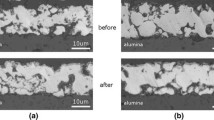Abstract
Line width and line thickness thermal strain components in passivated Al and Cu lines were observed to relax much more than the line length strain component. Although the width-to-thickness ratios were large, 3.5 and 4.4 for Al and Cu lines, respectively, the behaviors of the thermal stresses were far from the equibiaxial. Observed changes in deviatoric strains between room temperature and 190 °C for Al and 300 °C for Cu were consistent with a model in which the changes in line width and line thickness strains were simply related to changes in line length strains by the uniaxial Poisson’s ratio. Changes in line length strains were determined by the differences in metal and substrate thermal expansion coefficients and the magnitudes of temperature changes through retained elastic strain coefficients for Al of 30% for heating and for Cu of 60% for heating and 80% for cooling, with the balance accommodated by relaxation.









Similar content being viewed by others
References
I.-S. Yeo, P.S. Ho, and S.G.H. Anderson: Characteristics of thermal-stresses in Al(Cu) fine lines: I. Unpassivated line structures. J. Appl. Phys. 78, 945 (1995).
P.A. Flinn and C. Chiang: X-ray-diffraction determination of the effect of various passivations on stress in metal-films and patterned lines. J. Appl. Phys. 67, 2927 (1990).
P.R. Besser, S. Brennan, and J.C. Bravman: An x-ray method for direct determination of the strain state and strain relaxation in micron-scale passivated metallization lines during thermal cycling. J. Mater. Res. 9, 13 (1994).
P.R. Besser, T.N. Marieb, J. Lee, P.A. Flinn, and J.C. Bravman: Measurement and interpretation of strain relaxation in passivated Al-0.5% Cu lines. J. Mater. Res. 11, 184 (1996).
J.D. Eshelby: The determination of the elastic field of an ellipsoidal inclusion, and related problems. Proc. R. Soc. London, Ser. A 241, 376 (1957).
M.A. Korhonen, R.D. Black, and C.-Y. Li: Stress-relaxation of passivated aluminum line metallizations on silicon substrates. J. Appl. Phys. 69, 1748 (1991).
A.I. Sauter and W.D. Nix: Thermal-stresses in aluminum lines bonded to substrates. IEEE Trans. Compon. Hybrids and Manuf. Technol. 15, 594 (1992).
Y.L. Shen: On the elastic assumption for copper lines in interconnect stress modeling. IEEE Trans. Device Mater. Reliab. 8, 600 (2008).
P.C. Wang, G.S. Cargill III, I.C. Noyan, E.G. Liniger, C.-K. Hu, and K.Y. Lee: Thermal and electromigration strain distributions in 10 μm-wide Al conductor lines measured by x-ray microdiffraction, in Materials Reliability in Microelectronics VII, edited by J.J. Clement, R.R. Keller, K.S. Krisch, J.E. Sanchez Jr., and Z. Suo (Mater. Res. Soc. Symp. Proc. 473, Pittsburgh, PA, 1997), p. 273.
P.C. Wang, G.S. Cargill III, I.C. Noyan, and C.-K. Hu: Electromigration-induced stress in aluminum conductor lines measured by x-ray microdiffraction. Appl. Phys. Lett. 72, 1296 (1998).
N. Tamura, R.S. Celestre, A.A. MacDowell, H.A. Padmore, R. Spolenak, B.C. Valek, N.M. Chang, A. Manceau, and J.R. Patel: Submicron x-ray diffraction and its applications to problems in materials and environmental science. Rev. Sci. Instrum. 73, 1369 (2002).
H. Zhang, G.S. Cargill III, Y. Ge, A.M. Maniatty, and W. Liu: Strain evolution in Al conductor lines during electromigration. J. Appl. Phys. 104, 123533 (2008).
R.P. Vinci, E.M. Zielinski, and J.C. Bravman: Thermal stresses in passivated copper interconnects determined by x-ray analysis and finite element modeling, in Materials Reliability in Microelectronics IV, edited by P. Børgesen, J.C. Coburn, J.E. Sanchez Jr., K.P. Rodbell, and W.F. Filter (Mater. Res. Soc. Symp. Proc. 338, Pittsburgh, PA, 1994), p. 289.
R.P. Vinci, T.N. Marib, and J.C. Bravman: Non-destructive evaluation of strains and voiding in passivated copper metallizations, in Thin Films: Stresses and Mechanical Properties IV, edited by P.H. Townsend, T.P. Weihs, J.E. Sanchez Jr., and P. Børgesen (Mater. Res. Soc. Symp. Proc. 308, Pittsburgh, PA, 1993), p. 297.
J.M. Steigerwald, S.P. Murarka, and R.J. Gutmann: Chemical Mechanical Planarization of Microelectronic Materials (Wiley-Interscience, 1997).
G.E. Ice and B.C. Larson: 3D x-ray crystal microscope. Adv. Eng. Mater. 2, 643 (2000).
J.-S. Chung and G.E. Ice: Automated indexing for texture and strain measurement with broad-bandpass x-ray microbeams. J. Appl. Phys. 86, 5249 (1999).
N. Tamura, A.A. MacDowell, R.S. Celestre, H.A. Padmore, B. Valek, J.C. Bravman, R. Spolenak, W.L. Brown, T. Marieb, H. Fujimoto, B.W. Batterman, and J.R. Patel: High spatial resolution grain orientation and strain mapping in thin films using polychromatic submicron x-ray diffraction. Appl. Phys. Lett. 80, 3724 (2002).
H. Zhang: Thermal and electromigration induced strain and microstructure evolution in metal conductor lines. Ph.D. Thesis, Lehigh University, Pub. No. 3358117 (2009).
Acknowledgments
We thank Dr. C.-K. Hu at the IBM T.J. Watson Research Center for useful guidance and for providing the Cu conductor line samples and Y. Ge from Rensselaer Polytechnic Institute for helpful discussions regarding the analysis. The Al samples were provided by the Intel Corporation. The XRD experiments were carried out on beamline 34-ID of the APS, Argonne National Laboratory, where Dr. W. Liu provided valuable assistance with the synchrotron x-ray microdiffraction measurements and data analysis. Use of the APS was supported by the United States Department of Energy, Office of Science, Office of Basic Energy Sciences, under Contract No. DE-AC02-06CH11357. The present research was supported at Lehigh and Rensselaer Polytechnic Institute by National Science Foundation, Grant DMR-0312189.
Author information
Authors and Affiliations
Corresponding author
Rights and permissions
About this article
Cite this article
Zhang, H., Cargill, G.S. & Maniatty, A.M. Thermal strains in passivated aluminum and copper conductor lines. Journal of Materials Research 26, 633–639 (2011). https://doi.org/10.1557/jmr.2011.9
Received:
Accepted:
Published:
Issue Date:
DOI: https://doi.org/10.1557/jmr.2011.9




